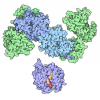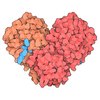[English] 日本語
 Yorodumi
Yorodumi- PDB-7o7z: Rabbit 80S ribosome stalled close to the mutated SARS-CoV-2 slipp... -
+ Open data
Open data
- Basic information
Basic information
| Entry | Database: PDB / ID: 7o7z | ||||||||||||
|---|---|---|---|---|---|---|---|---|---|---|---|---|---|
| Title | Rabbit 80S ribosome stalled close to the mutated SARS-CoV-2 slippery site by a pseudoknot (classified for pseudoknot) | ||||||||||||
 Components Components |
| ||||||||||||
 Keywords Keywords | RIBOSOME / Frameshift / virus / pseudoknot | ||||||||||||
| Function / homology |  Function and homology information Function and homology informationMajor pathway of rRNA processing in the nucleolus and cytosol / GTP hydrolysis and joining of the 60S ribosomal subunit / L13a-mediated translational silencing of Ceruloplasmin expression / SRP-dependent cotranslational protein targeting to membrane / Formation of a pool of free 40S subunits / Nonsense Mediated Decay (NMD) independent of the Exon Junction Complex (EJC) / Nonsense Mediated Decay (NMD) enhanced by the Exon Junction Complex (EJC) / ribosomal subunit / laminin receptor activity / ubiquitin ligase inhibitor activity ...Major pathway of rRNA processing in the nucleolus and cytosol / GTP hydrolysis and joining of the 60S ribosomal subunit / L13a-mediated translational silencing of Ceruloplasmin expression / SRP-dependent cotranslational protein targeting to membrane / Formation of a pool of free 40S subunits / Nonsense Mediated Decay (NMD) independent of the Exon Junction Complex (EJC) / Nonsense Mediated Decay (NMD) enhanced by the Exon Junction Complex (EJC) / ribosomal subunit / laminin receptor activity / ubiquitin ligase inhibitor activity / positive regulation of signal transduction by p53 class mediator / 90S preribosome / phagocytic cup / protein-RNA complex assembly / laminin binding / rough endoplasmic reticulum / ribosomal small subunit export from nucleus / translation regulator activity / gastrulation / MDM2/MDM4 family protein binding / cytosolic ribosome / class I DNA-(apurinic or apyrimidinic site) endonuclease activity / DNA-(apurinic or apyrimidinic site) lyase / maturation of LSU-rRNA from tricistronic rRNA transcript (SSU-rRNA, 5.8S rRNA, LSU-rRNA) / ribosomal large subunit biogenesis / positive regulation of apoptotic signaling pathway / maturation of SSU-rRNA from tricistronic rRNA transcript (SSU-rRNA, 5.8S rRNA, LSU-rRNA) / maturation of SSU-rRNA / small-subunit processome / spindle / cytoplasmic ribonucleoprotein granule / rRNA processing / antimicrobial humoral immune response mediated by antimicrobial peptide / rhythmic process / positive regulation of canonical Wnt signaling pathway / large ribosomal subunit / regulation of translation / protein guanylyltransferase activity / ribosome binding / RNA endonuclease activity producing 3'-phosphomonoesters, hydrolytic mechanism / mRNA guanylyltransferase activity / 5'-3' RNA helicase activity / virus receptor activity / Lyases; Phosphorus-oxygen lyases / ribosomal small subunit biogenesis / ribosomal small subunit assembly / Assembly of the SARS-CoV-2 Replication-Transcription Complex (RTC) / symbiont-mediated suppression of host cytoplasmic pattern recognition receptor signaling pathway via inhibition of TBK1 activity / Maturation of replicase proteins / small ribosomal subunit / 5S rRNA binding / TRAF3-dependent IRF activation pathway / ribosomal large subunit assembly / ISG15-specific peptidase activity / small ribosomal subunit rRNA binding / Transcription of SARS-CoV-2 sgRNAs / snRNP Assembly / Translation of Replicase and Assembly of the Replication Transcription Complex / large ribosomal subunit rRNA binding / Replication of the SARS-CoV-2 genome / cytosolic small ribosomal subunit / Hydrolases; Acting on ester bonds; Exoribonucleases producing 5'-phosphomonoesters / host cell endoplasmic reticulum-Golgi intermediate compartment / double membrane vesicle viral factory outer membrane / SARS coronavirus main proteinase / 5'-3' DNA helicase activity / 3'-5'-RNA exonuclease activity / host cell endosome / symbiont-mediated degradation of host mRNA / perikaryon / mRNA guanylyltransferase / symbiont-mediated suppression of host ISG15-protein conjugation / G-quadruplex RNA binding / symbiont-mediated suppression of host toll-like receptor signaling pathway / defense response to Gram-negative bacterium / symbiont-mediated suppression of host cytoplasmic pattern recognition receptor signaling pathway via inhibition of IRF3 activity / omega peptidase activity / SARS-CoV-2 modulates host translation machinery / mRNA (guanine-N7)-methyltransferase / methyltransferase cap1 / killing of cells of another organism / cytosolic large ribosomal subunit / host cell Golgi apparatus / symbiont-mediated suppression of host NF-kappaB cascade / symbiont-mediated perturbation of host ubiquitin-like protein modification / DNA helicase / methyltransferase cap1 activity / ubiquitinyl hydrolase 1 / cytoplasmic translation / cysteine-type deubiquitinase activity / cell differentiation / mRNA 5'-cap (guanine-N7-)-methyltransferase activity / tRNA binding / Hydrolases; Acting on peptide bonds (peptidases); Cysteine endopeptidases / single-stranded RNA binding / mitochondrial inner membrane / postsynaptic density / rRNA binding / regulation of autophagy / host cell perinuclear region of cytoplasm Similarity search - Function | ||||||||||||
| Biological species |    | ||||||||||||
| Method | ELECTRON MICROSCOPY / single particle reconstruction / cryo EM / Resolution: 2.4 Å | ||||||||||||
 Authors Authors | Bhatt, P.R. / Scaiola, A. / Leibundgut, M.A. / Atkins, J.F. / Ban, N. | ||||||||||||
| Funding support |  Switzerland, Switzerland,  Ireland, 2items Ireland, 2items
| ||||||||||||
 Citation Citation |  Journal: Science / Year: 2021 Journal: Science / Year: 2021Title: Structural basis of ribosomal frameshifting during translation of the SARS-CoV-2 RNA genome. Authors: Pramod R Bhatt / Alain Scaiola / Gary Loughran / Marc Leibundgut / Annika Kratzel / Romane Meurs / René Dreos / Kate M O'Connor / Angus McMillan / Jeffrey W Bode / Volker Thiel / David ...Authors: Pramod R Bhatt / Alain Scaiola / Gary Loughran / Marc Leibundgut / Annika Kratzel / Romane Meurs / René Dreos / Kate M O'Connor / Angus McMillan / Jeffrey W Bode / Volker Thiel / David Gatfield / John F Atkins / Nenad Ban /    Abstract: Programmed ribosomal frameshifting is a key event during translation of the severe acute respiratory syndrome coronavirus 2 (SARS-CoV-2) RNA genome that allows synthesis of the viral RNA-dependent ...Programmed ribosomal frameshifting is a key event during translation of the severe acute respiratory syndrome coronavirus 2 (SARS-CoV-2) RNA genome that allows synthesis of the viral RNA-dependent RNA polymerase and downstream proteins. Here, we present the cryo-electron microscopy structure of a translating mammalian ribosome primed for frameshifting on the viral RNA. The viral RNA adopts a pseudoknot structure that lodges at the entry to the ribosomal messenger RNA (mRNA) channel to generate tension in the mRNA and promote frameshifting, whereas the nascent viral polyprotein forms distinct interactions with the ribosomal tunnel. Biochemical experiments validate the structural observations and reveal mechanistic and regulatory features that influence frameshifting efficiency. Finally, we compare compounds previously shown to reduce frameshifting with respect to their ability to inhibit SARS-CoV-2 replication, establishing coronavirus frameshifting as a target for antiviral intervention. | ||||||||||||
| History |
|
- Structure visualization
Structure visualization
| Movie |
 Movie viewer Movie viewer |
|---|---|
| Structure viewer | Molecule:  Molmil Molmil Jmol/JSmol Jmol/JSmol |
- Downloads & links
Downloads & links
- Download
Download
| PDBx/mmCIF format |  7o7z.cif.gz 7o7z.cif.gz | 5.2 MB | Display |  PDBx/mmCIF format PDBx/mmCIF format |
|---|---|---|---|---|
| PDB format |  pdb7o7z.ent.gz pdb7o7z.ent.gz | Display |  PDB format PDB format | |
| PDBx/mmJSON format |  7o7z.json.gz 7o7z.json.gz | Tree view |  PDBx/mmJSON format PDBx/mmJSON format | |
| Others |  Other downloads Other downloads |
-Validation report
| Summary document |  7o7z_validation.pdf.gz 7o7z_validation.pdf.gz | 2 MB | Display |  wwPDB validaton report wwPDB validaton report |
|---|---|---|---|---|
| Full document |  7o7z_full_validation.pdf.gz 7o7z_full_validation.pdf.gz | 2.1 MB | Display | |
| Data in XML |  7o7z_validation.xml.gz 7o7z_validation.xml.gz | 382.3 KB | Display | |
| Data in CIF |  7o7z_validation.cif.gz 7o7z_validation.cif.gz | 657.6 KB | Display | |
| Arichive directory |  https://data.pdbj.org/pub/pdb/validation_reports/o7/7o7z https://data.pdbj.org/pub/pdb/validation_reports/o7/7o7z ftp://data.pdbj.org/pub/pdb/validation_reports/o7/7o7z ftp://data.pdbj.org/pub/pdb/validation_reports/o7/7o7z | HTTPS FTP |
-Related structure data
| Related structure data |  12757MC  7o7yC  7o80C  7o81C M: map data used to model this data C: citing same article ( |
|---|---|
| Similar structure data |
- Links
Links
- Assembly
Assembly
| Deposited unit | 
|
|---|---|
| 1 |
|
- Components
Components
-RNA chain , 7 types, 7 molecules A2AHAIATB5B7B8
| #1: RNA chain | Mass: 603928.250 Da / Num. of mol.: 1 / Source method: isolated from a natural source / Source: (natural)  |
|---|---|
| #9: RNA chain | Mass: 70601.500 Da / Num. of mol.: 1 / Source method: obtained synthetically Source: (synth.)  References: GenBank: NC_045512.2 |
| #10: RNA chain | Mass: 15209.544 Da / Num. of mol.: 1 / Source method: isolated from a natural source / Source: (natural)  |
| #11: RNA chain | Mass: 24889.115 Da / Num. of mol.: 1 / Source method: isolated from a natural source / Source: (natural)  |
| #39: RNA chain | Mass: 1557519.500 Da / Num. of mol.: 1 / Source method: isolated from a natural source / Source: (natural)  |
| #40: RNA chain | Mass: 38851.871 Da / Num. of mol.: 1 / Source method: isolated from a natural source / Source: (natural)  |
| #41: RNA chain | Mass: 50809.047 Da / Num. of mol.: 1 / Source method: isolated from a natural source / Source: (natural)  |
-40S ribosomal protein ... , 18 types, 18 molecules AAADAZAaAcAfAgAhAkAlAnAoAqArAtAwAxAy
| #2: Protein | Mass: 9480.186 Da / Num. of mol.: 1 / Source method: isolated from a natural source / Source: (natural)  |
|---|---|
| #5: Protein | Mass: 14498.884 Da / Num. of mol.: 1 / Source method: isolated from a natural source / Source: (natural)  |
| #12: Protein | Mass: 32970.023 Da / Num. of mol.: 1 / Source method: isolated from a natural source / Source: (natural)  |
| #13: Protein | Mass: 30002.061 Da / Num. of mol.: 1 / Source method: isolated from a natural source / Source: (natural)  |
| #15: Protein | Mass: 31146.607 Da / Num. of mol.: 1 / Source method: isolated from a natural source / Source: (natural)  References: UniProt: G1TNM3, DNA-(apurinic or apyrimidinic site) lyase |
| #18: Protein | Mass: 28751.906 Da / Num. of mol.: 1 / Source method: isolated from a natural source / Source: (natural)  |
| #19: Protein | Mass: 47356.172 Da / Num. of mol.: 1 / Source method: isolated from a natural source / Source: (natural)  |
| #20: Protein | Mass: 24263.387 Da / Num. of mol.: 1 / Source method: isolated from a natural source / Source: (natural)  |
| #23: Protein | Mass: 18468.826 Da / Num. of mol.: 1 / Source method: isolated from a natural source / Source: (natural)  |
| #24: Protein | Mass: 14538.987 Da / Num. of mol.: 1 / Source method: isolated from a natural source / Source: (natural)  |
| #26: Protein | Mass: 16302.772 Da / Num. of mol.: 1 / Source method: isolated from a natural source / Source: (natural)  |
| #27: Protein | Mass: 17049.182 Da / Num. of mol.: 1 / Source method: isolated from a natural source / Source: (natural)  |
| #29: Protein | Mass: 15552.119 Da / Num. of mol.: 1 / Source method: isolated from a natural source / Source: (natural)  |
| #30: Protein | Mass: 17801.814 Da / Num. of mol.: 1 / Source method: isolated from a natural source / Source: (natural)  |
| #32: Protein | Mass: 13398.763 Da / Num. of mol.: 1 / Source method: isolated from a natural source / Source: (natural)  |
| #35: Protein | Mass: 15860.666 Da / Num. of mol.: 1 / Source method: isolated from a natural source / Source: (natural)  |
| #36: Protein | Mass: 15107.924 Da / Num. of mol.: 1 / Source method: isolated from a natural source / Source: (natural)  |
| #37: Protein | Mass: 13645.028 Da / Num. of mol.: 1 / Source method: isolated from a natural source / Source: (natural)  |
+Ribosomal Protein ... , 28 types, 28 molecules ABACAEAbAdAeAiAsAuAvBABBBFBGBJBLBMBNBOBQBSBUBVBYBjBrBtBv
+Protein , 21 types, 21 molecules AFAGAjAmApBDBKBPBTBWBXBcBdBeBfBhBkBlBoBpBs
-60S ribosomal protein ... , 12 types, 12 molecules AzBCBEBHBIBRBZBaBbBgBiBm
| #38: Protein/peptide | Mass: 3473.451 Da / Num. of mol.: 1 / Source method: isolated from a natural source / Source: (natural)  |
|---|---|
| #44: Protein | Mass: 46430.895 Da / Num. of mol.: 1 / Source method: isolated from a natural source / Source: (natural)  |
| #46: Protein | Mass: 33028.336 Da / Num. of mol.: 1 / Source method: isolated from a natural source / Source: (natural)  |
| #49: Protein | Mass: 21871.418 Da / Num. of mol.: 1 / Source method: isolated from a natural source / Source: (natural)  |
| #50: Protein | Mass: 24643.057 Da / Num. of mol.: 1 / Source method: isolated from a natural source / Source: (natural)  |
| #59: Protein | Mass: 23535.281 Da / Num. of mol.: 1 / Source method: isolated from a natural source / Source: (natural)  |
| #67: Protein | Mass: 15835.831 Da / Num. of mol.: 1 / Source method: isolated from a natural source / Source: (natural)  |
| #68: Protein | Mass: 16635.551 Da / Num. of mol.: 1 / Source method: isolated from a natural source / Source: (natural)  |
| #69: Protein | Mass: 26721.727 Da / Num. of mol.: 1 / Source method: isolated from a natural source / Source: (natural)  |
| #74: Protein | Mass: 13326.074 Da / Num. of mol.: 1 / Source method: isolated from a natural source / Source: (natural)  |
| #76: Protein | Mass: 12263.834 Da / Num. of mol.: 1 / Source method: isolated from a natural source / Source: (natural)  |
| #80: Protein | Mass: 14800.474 Da / Num. of mol.: 1 / Source method: isolated from a natural source / Source: (natural)  |
-Non-polymers , 6 types, 2907 molecules 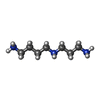
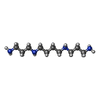

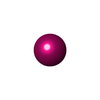







| #87: Chemical | ChemComp-SPD / #88: Chemical | #89: Chemical | ChemComp-MG / #90: Chemical | ChemComp-UNX / #91: Chemical | ChemComp-ZN / #92: Water | ChemComp-HOH / | |
|---|
-Experimental details
-Experiment
| Experiment | Method: ELECTRON MICROSCOPY |
|---|---|
| EM experiment | Aggregation state: PARTICLE / 3D reconstruction method: single particle reconstruction |
- Sample preparation
Sample preparation
| Component |
| ||||||||||||||||||||||||||||||||||||
|---|---|---|---|---|---|---|---|---|---|---|---|---|---|---|---|---|---|---|---|---|---|---|---|---|---|---|---|---|---|---|---|---|---|---|---|---|---|
| Molecular weight | Experimental value: NO | ||||||||||||||||||||||||||||||||||||
| Source (natural) |
| ||||||||||||||||||||||||||||||||||||
| Source (recombinant) |
| ||||||||||||||||||||||||||||||||||||
| Buffer solution | pH: 7.4 | ||||||||||||||||||||||||||||||||||||
| Specimen | Conc.: 0.3 mg/ml / Embedding applied: NO / Shadowing applied: NO / Staining applied: NO / Vitrification applied: YES | ||||||||||||||||||||||||||||||||||||
| Specimen support | Grid material: COPPER / Grid mesh size: 400 divisions/in. / Grid type: Quantifoil R2/2 | ||||||||||||||||||||||||||||||||||||
| Vitrification | Instrument: FEI VITROBOT MARK IV / Cryogen name: ETHANE-PROPANE / Humidity: 100 % / Chamber temperature: 277 K |
- Electron microscopy imaging
Electron microscopy imaging
| Experimental equipment |  Model: Titan Krios / Image courtesy: FEI Company |
|---|---|
| Microscopy | Model: FEI TITAN KRIOS |
| Electron gun | Electron source:  FIELD EMISSION GUN / Accelerating voltage: 300 kV / Illumination mode: FLOOD BEAM FIELD EMISSION GUN / Accelerating voltage: 300 kV / Illumination mode: FLOOD BEAM |
| Electron lens | Mode: BRIGHT FIELD / Nominal magnification: 81000 X / Calibrated magnification: 56604 X / Cs: 2.7 mm / C2 aperture diameter: 100 µm |
| Specimen holder | Cryogen: NITROGEN / Specimen holder model: FEI TITAN KRIOS AUTOGRID HOLDER |
| Image recording | Electron dose: 60 e/Å2 / Film or detector model: GATAN K3 (6k x 4k) |
| EM imaging optics | Energyfilter name: GIF Quantum LS / Energyfilter slit width: 20 eV |
- Processing
Processing
| EM software |
| ||||||||||||||||||||||||||||
|---|---|---|---|---|---|---|---|---|---|---|---|---|---|---|---|---|---|---|---|---|---|---|---|---|---|---|---|---|---|
| CTF correction | Type: PHASE FLIPPING AND AMPLITUDE CORRECTION | ||||||||||||||||||||||||||||
| Symmetry | Point symmetry: C1 (asymmetric) | ||||||||||||||||||||||||||||
| 3D reconstruction | Resolution: 2.4 Å / Resolution method: FSC 0.143 CUT-OFF / Num. of particles: 171706 / Symmetry type: POINT |
 Movie
Movie Controller
Controller








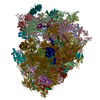
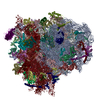
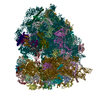
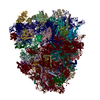

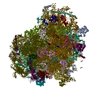


 PDBj
PDBj





















